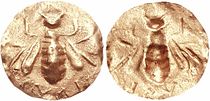
Back Obolo AN Obol Azerbaijani Абол Byelorussian Абол BE-X-OLD Обол Bulgarian Obolenn Breton Òbol Catalan Obolos Czech Obol Welsh Obolus German
Obols through history
Silver obol of Athens, dated 515–510 BC. Obv. Gorgoneion Rev. Incuse square.
Charon's obol. 5th–1st century BC.
A 19th-century obol from the British-occupied Ionian Islands
The obol (Greek: ὀβολός, obolos, also ὀβελός (obelós), ὀβελλός (obellós), ὀδελός (odelós). lit. "nail, metal spit";[1] Latin: obolus) was a form of ancient Greek currency and weight.





